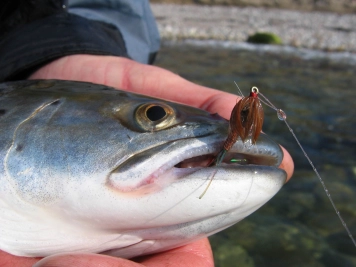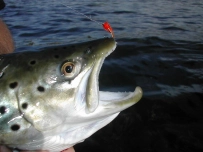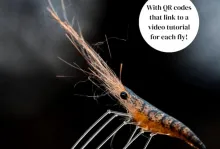This is the true story of Klympen - a sea trout fly pattern, which I witnessed being created - and have seen evolve into something surprisingly far from the original.
We all know that the same fly pattern tied by different people can come out very differently. Some dress flies lightly for a delicate look, some tie beefy flies, some simply overdress and some tiers can't tie worth *beep* and tie downright ugly and clumsy flies, hard to relate to the original simply because they are badly made. We have all been there...
Tracing back
I often try to trace flies back to the origin when I start tying a pattern or mention it in an article. I like to know its history and have the look of the fly as tied by the originator as a starting point when tying my own. I might vary the fly a bit according to my taste or adapt it to my fishing, but I do like to make my flies look somewhat like the fly that the originator envisioned - or at least know what the originator envisioned and realize that I'm doing a variation.
Sometimes it's very hard to find the origins of a pattern, and when researching, I'm often surprised over what I find. Flies evolve and I know that, but some stray very far away from the outset. I have a large library with hundreds of fly-tying books, I know lots of online resources and I have a large network of fly-tyers, all of which can come into play when I try to trace a pattern. And still it can be hard.
The opposite way
In the case of the fly covered in this article - the sea trout fly Klympen - I have gone the opposite way tracing it forward from the origin and towards what it has become.
I happen to know the origin and the originator, my good friend Henning Eskol, very well and basically witnessed the birth of the fly and saw if not the first then some of the very first versions more than 10 years ago. I have seen many specimens of this fly tied by the guy who came up with the pattern, and know exactly how it looks and why, when coming from the hands of the originator.
With that as a starting point I have tried to trace the pattern "forward" in time and seen what it has become - which has honestly surprised me a bit. Some of the variations bearing the name of this fly are very far from what it was originally designed to be.
Both he and I have varied the fly, and already from Henning's hands it has developed away from the first specimens, but not as far as some of the very distant ones.
Toto, I've a feeling we're not in Kansas any more
The reason for looking at this fly in particular was a mention by Dutch friend Richard Maree, who asked during a fishing trip here in Denmark:
"Do you know this Norwegian fly, Klympen?"
He then produced a very un-Klympen like little orange nymph fly. Both Henning and I were baffled. Klympen isn't in any way Norwegian, but Danish, and the fly Richard showed us was pretty far from a Klympen as Henning and I knew it.
The original Klympen is a fly that's tied and shaped as it is for several reasons. The main traits are a dense copper wire body, a slim rear and a thicker front - partly inspired by a Big Hole Demon.
Do you know this Norwegian fly, Klympen?
The real origin
The fly was first tied more than 10 years ago in the beginning of the 2000's during a trip to the Danish island Bornholm in the Baltic where Henning - famous for his low backcasts - wanted a fly that could endure a contact or two with the rocks in the shallow water behind the edge of the deeper water at the Bornholm location called Klympen.
He was tired of tinsel bodies and ribs breaking and unraveling, and by making a body of solid copper wire covered with varnish, he got a very durable fly, which as an added bonus was nicely heavy, a benefit appreciated by many sea trout fly anglers including Henning and myself.
The fly was tied using mallard fibers and flash for a tail, had a copper wire body, gun metal flash chenille for a thorax and a soft, tan hackle in the front. Easy to tie, durable and - soon to be revealed - a great sea trout fly. A true producer.
The SIDS sea trout
Henning wrote this on our internal fishing report web site back in 2003:
I tie it in several versions. Common traits for this fly are the rear body made from copper wire, a dense thorax and a front hackle as well as a long tail.
Good variations are orange SLF or natural hare's ear.
The hook must of course be a Kamasan B170."
You can see an image of that exact fly in the top of this article.
The very first registration we have on the same site of Klympen is a sea trout very renowned among us friends. It is internally referred to as the SIDS sea trout (The Sudden Infant Death Syndrome trout, in Danish: Den Vuggedøde). So named because Henning cradles it like an infant on the images taken right after the catch.
The fish was far from being an infant, actually, but rather a very, very healthy 10 lbs. or close to 5 kilos, silver bright sea run brown, and one of the fish we still remember and talk about now, more than a decade after its catch.
Klympen has since proved itself time and time again as the pictures on this page documents. They are just a few of the many Klympen trophy shots in the archive.
Spinning off
As a result of the initial success, the fly soon spawned a number of spinoffs. The small and simplified orange version was the first one and also the most successful variation, which I personally have tied and fished a lot.
Other variations were made in different colors, materials and shapes, and I personally tied and favored a version on a curved emerger hook tied with natural tan materials. I have fished quite a bit with this version sometimes with no tail or flash. It has caught me sea trout in the ocean as well as rainbows in lakes.
All the way through, the copper wire body has been the one thing that tied the flies together in the Klympen family.
Same same but different
It seems that it's the very simple, orange version that has been picked up - particularly by the Norwegians, who have developed the fly pretty far from the original, both with regards to shape, materials and even color.
A lot of people tie this fly, and it's surprisingly widespread on the web. You can find articles, images and videos covering the fly. Most have no source for the original, a few try to trace the fly back to its origins, but even fewer get it right.
Most agree that it's a sea trout pattern. So far so good.
Most have a slim rear and a fat front. Also OK.
A few use the all important copper wire, a hallmark for the fly.
Even fewer have a tail or a front hackle, which are very distinct on the original.
Ceci n'est pas une pipe
I have no problems with variations on flies. I do them all the time, and I know that many of the flies, which I tie and call by their original name - the Bloody Butcher, the Big Hole Demon, the Red Tag, the Muddler Minnow and many, many more, mostly aren't anywhere near the originals.
But I know that they aren't!
I realize that my flies have strayed away from the originals and that my sources of inspiration might not even be the original, but something maybe just similar to it.
I don't expect people to be Latter-day Saints when it comes to fly patterns. I'm an infidel myself and adapt any pattern to my liking. But I do like it when people do just a little to trace the flies they are tying, and know who they owe for their creation.
I personally get a kick out of seeing where a given pattern came from and what it evolved into.
I hope that people will get a similar kick from this article.
The variations
I have collected a small bunch of variations from the web and hope that the people who tied and photographed the flies will forgive me - and maybe even feel thrilled - that I included their flies and pictures in the article. If not, let me know, and I will immediately remove you from the story.
|
|
Emil La Beet (Denmark), December 2013
Emil mentions that he has seen the fly discussed in connection with Norwegian sea trout fishing.
This fly is also pretty far from the original. The shape is recognizable, somewhat like the simpler orange variations but lacking the copper wire body, which is tying thread and tinsel rib here.
Emil notices in his description that the Klympen flies only have the copper wire body in common - which is true - and that he might consider tying one with copper.
|
|
Frode Henriksen (Norway), December 2013
This Norwegian variation is about as far away from Henning's fly as can be. No materials from the original are used and there's no tail or front hackle.
The author does note in the article that he has been made aware "...the original is from Denmark and the fly's father is Henning Eskol. His variant is basically not particularly like this one, but it is his name that appears."
Well, Eskol's variant is basically not a variant, but the original...
Many more
There are many more variations to be found out there, but remember: you saw the original here.
|
|
|
|
Englander (UK), December 2009
This version found in a UK forum is pretty close to the orange version, which we have fished here for a long time. The author Englander wites:
"I came across this fella they tie it on B175 size 6 the author said he'd found it effective for still water rainbows."
I have o idea what that source is, but he notes that he exchanged the seal's fur for Arctic fox and thus unknowingly came closer to the original.
|
|
Eivind Baerulfsen (Norway), November 2011
Eivind sells flies, and has Klympen in his assortment. He writes that it's tied with "orange seal fur. Weighted with copperwire". He calls the fly a must-have fly, and several other people mention him and his videos as a source and inspiration for Klympen flies.
|
|
swedeElvis (Norway or Sweden), March 2014
The tier writes "They say that Klympen should be good. A fly that has seal's fur dubbed in the top of the fly. I had no seal's fur so I took what I had. Not quite as Klympen, but something."
The body sure is cool, and a nice fly, but a distant family member in the Klympen family.
|
|
There is of course many flies that have the shape and look of the Klympen. Being essentially a variation of a classic soft hackle style fly, it has to be so. This last one is not called a variation of Klympen, but seen in the light of the above, The Midnight Stalker could very well be.
- Log in to post comments



































